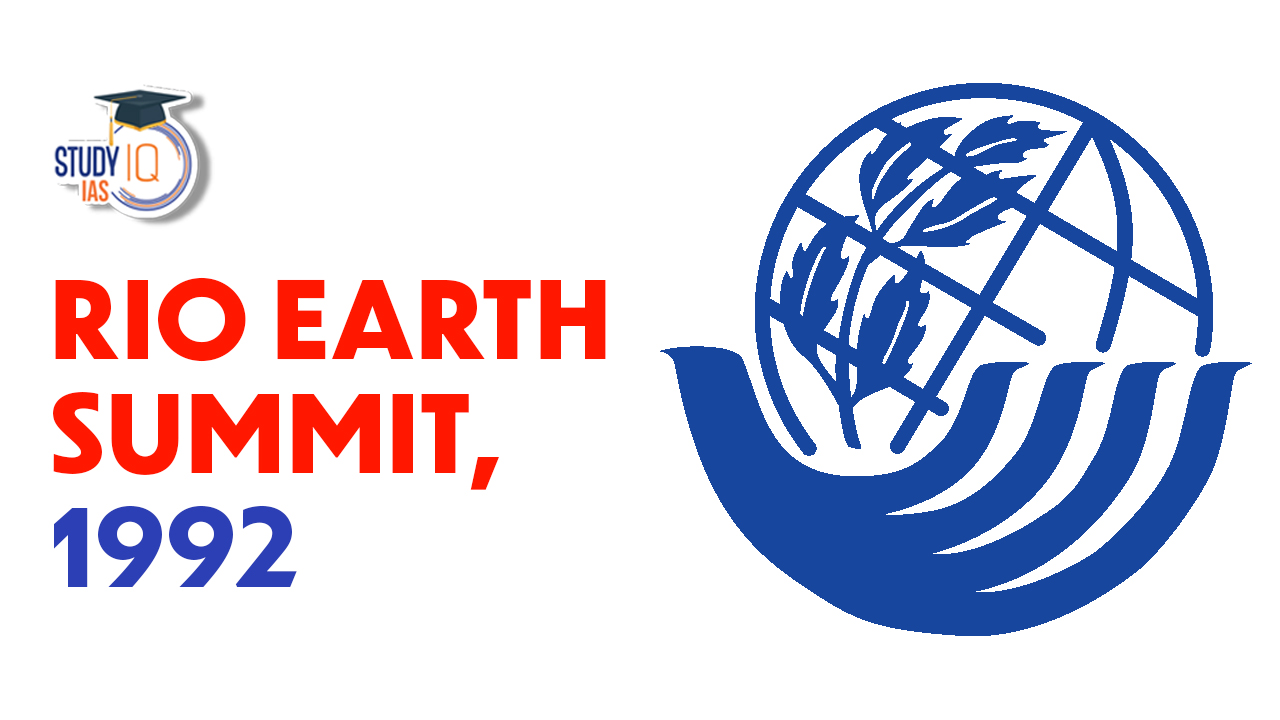Table of Contents
Rio Earth Summit 1992
The United Nations Conference on Environment and Development (UNCED), often known as the Earth Summit or Rio Summit or Rio Conference, took place from June 3 through June 14, 1992. The Rio Summit aimed to establish a thorough agenda and a novel approach for international action on environmental and development issues in the twenty-first century.
The Earth Summit of 1992 came to the conclusion that sustainable development could be achieved while emphasizing economic, social, and environmental issues. 179 head of state and government representatives gathered in Rio de Janeiro for the Earth Summit in 1992. This occasion also served as UNCED’s official debut. Agenda 21 was one of the summit’s most prominent outcomes.
Rio Earth Summit 1992 Overview
Rio summit did take place on a significant scale and had positive outcomes, the majority of its goals were not met. Various agendas and treaties were started with ideas and objectives that were not fully realized, leaving them unfulfilled. The Rio summit’s major focus was on reducing temperatures, although this has become increasingly difficult in recent years. No matter where somebody is, sustainable development can be accomplished, according to the consensus at the 1992 Rio Summit. To create a sustainable ecosystem, economic, social, and environmental factors must all be balanced.
| Rio Earth Summit 1992 Overview |
|
| Particulars | Details |
| Rio Summit is also known as | Earth Summit, Rio de Janeiro Earth Summit, Rio Conference, and Rio Summit. |
| Earth Summit 1992 was held in which city | Rio de Janeiro, Brazil. |
| Rio Earth Summit of 1992 Outcome |
|
| The ‘Agenda 21’ of Rio Summit 1992 is related to | Environment and Sustainable Development. |
| Environmental Treaties of Rio Summit |
|
What is Rio Earth Summit 1992?
The Earth Summit was held in Stockholm, Sweden, on the 20th anniversary of the 1972 United Nations Conference on the Human Environment. The Stockholm Declaration and Plan of Action were adopted at the summit in 1972, which was the first ever environmental meeting of that caliber.
The Convention on Biological Diversity is related to the Rio conference. The fundamental tenet of the 1992 Rio Earth Summit was to reconsider the situation of the planet today and to implement practical measures to reduce pollution. 2400 representatives of the NGOs and 172 countries participated in this meeting. This Earth summit demonstrated the value of the environment and people’s attitudes toward it.
Features of Rio Earth Summit 1992
In the Brazilian city of Rio de Janeiro, the Earth Summit took place in 1992. The summit was attended by the leaders of 118 governments and over 178 countries. As a result, the Rio Declaration, which reaffirmed the ideals of sustainable development, was born from the Earth Summit. The Rio Earth Summit had the following significant elements:
- The goal of the action plan Agenda 21 was to spread sustainable development throughout the ensuing years.
- The Rio Declaration, which was intended to serve as a roadmap for environmental and economic progress, contained 27 principles.
- The right of governments to use their resources in accordance with the principles of sustainable forest management was stressed in the Forest Principles.
- The Earth Summit also unveiled a number of policies intended to lessen the threat of global warming and the global impact of climate change.
Rio Earth Summit 1992 Outcome
The 1992 Rio Summit, also known as the Earth Summit, had an impact on all countries. Based on the conclusions, reports, or designs produced at this summit, a number of international measures were done. It is crucial to understand that even the Kyoto Protocol and the Earth Summit 2002 adhered to the guidelines set forth at the 1992 Rio Earth Summit. The following developments came about as a result of the Rio Earth Summit:
- Rio Declaration on Environment and Development
- Agenda 21
- Forest Principles
Rio Declaration on Environment and Development
The Rio Declaration on Environment and Development, a collection of guiding principles, describes the rights and obligations of states in the areas of environmental protection and sustainable development. The UN produced this crucial document and guideline for upcoming generations. The Rio Declaration on Environment and Development states that nations may use natural resources inside their boundaries as long as doing so does not impair the surroundings of other nations.
Rio Earth Summit Agenda 21
Agenda 21 was the second-most significant result of the Rio meeting in 1992. It is a carefully constructed blueprint for sustainable growth. Environmental issues are addressed by this agenda through social and economic strategies. The UN Commission on Sustainable Development is tasked with carrying out Agenda 21.
The 1992 Rio summit’s “agenda 21” had to do with the environment and sustainable development. The following four categories are included in the Agenda 21 suggested during the Rio summit:
- Strengthening the Role of Major Groups
- Resources for Development Conservation and Management
- Social and Economic Dimensions
- Means of Implementation
Rio Earth Summit 1992 Forest Principles
The forest concept is the summit’s other significant consequence. Rio Forest principles is another name for them. The UN’s forest principles are a non-binding legal framework built on forestry development and preservation. After discussions with industrialized nations, this document was the outcome of compromise.
Environmental Treaties of Rio Earth Summit 1992
The Rio summit is also renowned for producing the two following treaties, which have received widespread recognition from different countries. Two Rio Summit environmental agreements are:
- United Nations Framework Convention on Climate Change
- Convention on Biological Diversity
United Nations Framework Convention on Climate Change
The Earth summit in 2022 also included a proposal for this international agreement. The UNFCCC is another name for the UN Framework Convention on Climate Change. In order to concentrate on the problem of greenhouse gas emissions, a significant treaty was suggested. More than 190 countries ratified the UNFCCC as an agreement.
Convention on Biological Diversity
The 1992 Rio conference had a significant impact on biodiversity among other things. The goal of the Convention on Biological Diversity was to protect biodiversity. 180 countries joined together to sign this significant agreement. Regarding biological reserves, the objectives of the convention on biological diversity were as follows:
- Resources’ sustainable use
- Resources’ fair and equitable sharing.
- Biodiversity conservation
Importance of Rio Earth Summit 1992
International environmental cooperation reached a turning point with the Rio Earth Summit. This is because the Summit served as the starting point for a number of later international agreements, including the Kyoto Protocol and the Paris Climate Agreement. That’s not all, though. The Summit also emphasized the necessity for international action to solve interconnected problems like poverty, environmental degradation, and social injustice.
The Rio Earth Summit helped to further international efforts for environmental preservation and sustainable development. As a result, comprehensive programs like Agenda 21 might be adopted.
Rio Earth Summit 1992 UPSC
For applicants preparing for the tests given by the Union Public Service Commission, the Rio summit is a crucial subject. Rio Summit, Rio Conference, Rio Earth Summit, and Earth Summit are additional names for the 1992 Rio Summit. The conference in Rio de Janeiro highlighted interdependence and mutual development. Examining industrial practices, protecting the oceans, reducing automobile emissions, and sustainable development were significant facets of the Earth Summit.


 NATO Countries List 2025, Members, Funct...
NATO Countries List 2025, Members, Funct...
 UPSC Prelims Syllabus 2025 PDF, Check Su...
UPSC Prelims Syllabus 2025 PDF, Check Su...
 UPSC Toppers 2024 Felicitation Program b...
UPSC Toppers 2024 Felicitation Program b...





















